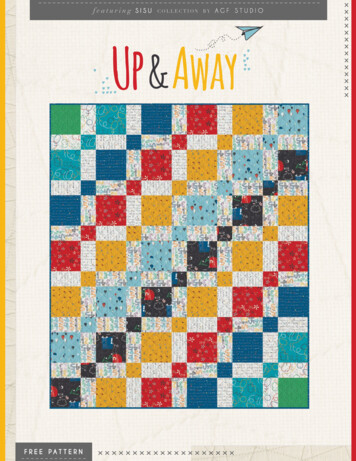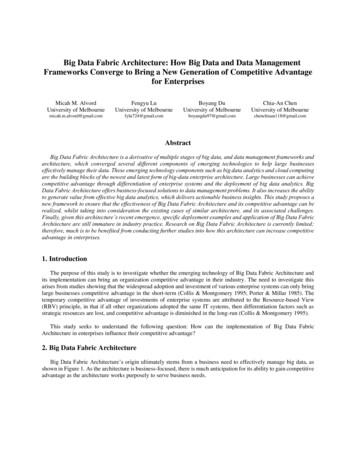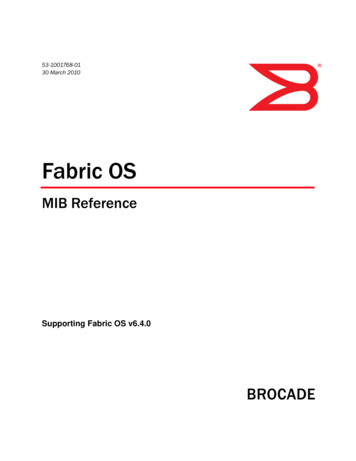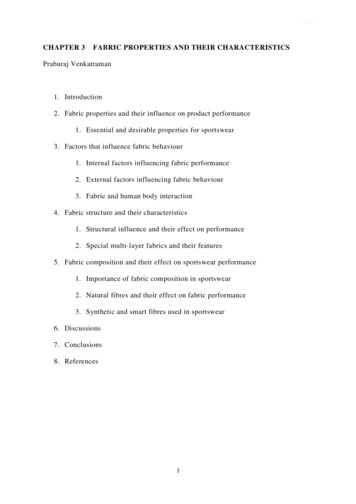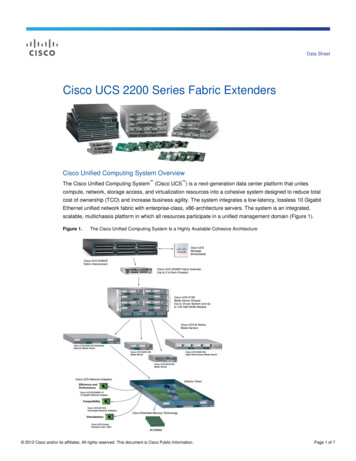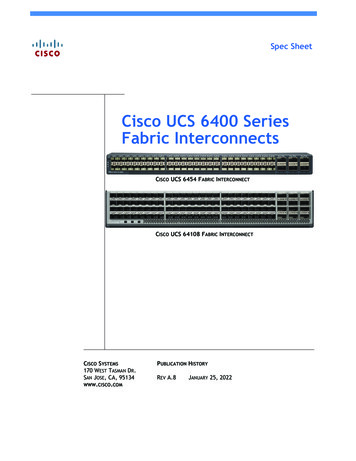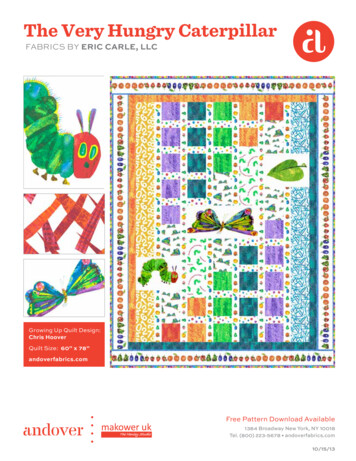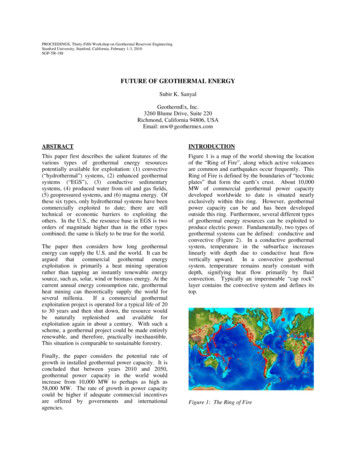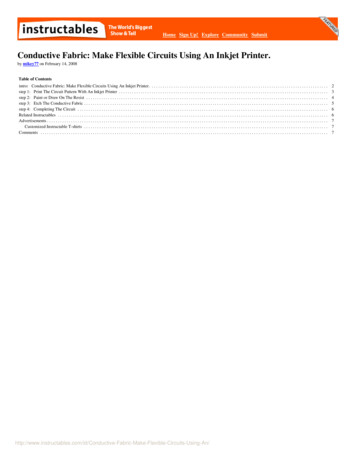
Transcription
Home Sign Up! Explore Community SubmitConductive Fabric: Make Flexible Circuits Using An Inkjet Printer.by mikey77 on February 14, 2008Table of Contentsintro: Conductive Fabric: Make Flexible Circuits Using An Inkjet Printer. . . . . . . . . . . . . . . . . . . . . . . . . . . . . . . . . . . . . . . . . . . . . . . . . . . . . . . . . . . . . . . . . . . . . . . . . . . . . . . . . .step 1: Print The Circuit Pattern With An Inkjet Printer . . . . . . . . . . . . . . . . . . . . . . . . . . . . . . . . . . . . . . . . . . . . . . . . . . . . . . . . . . . . . . . . . . . . . . . . . . . . . . . . . . . . . . . . . . . . . . . .step 2: Paint or Draw On The Resist . . . . . . . . . . . . . . . . . . . . . . . . . . . . . . . . . . . . . . . . . . . . . . . . . . . . . . . . . . . . . . . . . . . . . . . . . . . . . . . . . . . . . . . . . . . . . . . . . . . . . . . . . . . . . . .step 3: Etch The Conductive Fabric . . . . . . . . . . . . . . . . . . . . . . . . . . . . . . . . . . . . . . . . . . . . . . . . . . . . . . . . . . . . . . . . . . . . . . . . . . . . . . . . . . . . . . . . . . . . . . . . . . . . . . . . . . . . . . . .step 4: Completing The Circuit . . . . . . . . . . . . . . . . . . . . . . . . . . . . . . . . . . . . . . . . . . . . . . . . . . . . . . . . . . . . . . . . . . . . . . . . . . . . . . . . . . . . . . . . . . . . . . . . . . . . . . . . . . . . . . . . . . .Related Instructables . . . . . . . . . . . . . . . . . . . . . . . . . . . . . . . . . . . . . . . . . . . . . . . . . . . . . . . . . . . . . . . . . . . . . . . . . . . . . . . . . . . . . . . . . . . . . . . . . . . . . . . . . . . . . . . . . . . . . . . . . . . .Advertisements . . . . . . . . . . . . . . . . . . . . . . . . . . . . . . . . . . . . . . . . . . . . . . . . . . . . . . . . . . . . . . . . . . . . . . . . . . . . . . . . . . . . . . . . . . . . . . . . . . . . . . . . . . . . . . . . . . . . . . . . . . . . . . . . .Customized Instructable T-shirts . . . . . . . . . . . . . . . . . . . . . . . . . . . . . . . . . . . . . . . . . . . . . . . . . . . . . . . . . . . . . . . . . . . . . . . . . . . . . . . . . . . . . . . . . . . . . . . . . . . . . . . . . . . . . . . .Comments . . . . . . . . . . . . . . . . . . . . . . . . . . . . . . . . . . . . . . . . . . . . . . . . . . . . . . . . . . . . . . . . . . . . . . . . . . . . . . . . . . . . . . . . . . . . . . . . . . . . . . . . . . . . . . . . . . . . . . . . . . . . . . . . . . . -Make-Flexible-Circuits-Using-An/234566777
intro: Conductive Fabric: Make Flexible Circuits Using An Inkjet Printer.Extremely flexible and nearly transparent circuits can be made using conductive fabrics. Here are some of the experiments I've done with conductive fabrics. They can be painted ordrawn on with resist and then etched like a standard circuit board. Conductive glue or conductive thread is then used to attach the components to the fabric circuit board.To make this clear, the inkjet printer is not used to directly print resist onto the fabric. Instead, it is only used to print the circuit design onto the conductive fabric. You will then have tohand paint a clear resist over the inkjet image before the circuit can be etched.See step 1 for details on a printer that may work to directly print the resist onto conductive fabric.Alternately--an inkjet printer is not necessary--you can just freehand paint or draw on the resist where you want the conductive traces to be.Pic 1 shows a simple circuit that that lights 3 LEDs. I made some of the traces circular to find out if they would conduct well at angles to the warp and weft of the fabric.MaterialsPerformix (tm) liquid tape, black-Available at Wal-Mart or http://www.thetapeworks.com/liquid-tape.htmCarbon Graphite, fine powder- Available in larger quantities at http://www.elementalscientific.net/Available in smaller quantities at your local hardware store. It's called lubricating graphite and comes in small tubes or bottles.Conductive thread-Available in small spools at: http://members.shaw.ca/ubik/thread/order.htmlor at: ath 2 135Conductive fabrics available from: http://www.lessemf.com/fabric.htmlClear Nail PolishCrayonsFerric Chloride etchant available at: 5/DRY CONCENTRATED ETCHANT .htmlor at: ery ferric chlorideInkjet printertoluol solvent-available at hardware storeswax paperPic 2 shows the three conductive fabrics that were used in this instructable.1-VeilShield-A mesh polyester plated with a blackened copper. Very light and 70% transparent.2-FlecTron-copper plated nylon ripstop.3-Nickel Mesh-Semi-transparent copper and nickel coated polyester.pic 3 shows the back of the circuit and the glued components.Image Notes1. FlecTron-Copper plated nylon2. Nickel Mesh-Copper and Nickel plated polyester3. VeilShield-Copper plated mesh, nearly ive-Fabric-Make-Flexible-Circuits-Using-An/
step 1: Print The Circuit Pattern With An Inkjet PrinterCreate a black and white image in a drawing or image program that will be the pattern for your circuit. Print it out onto the center of a piece of copy paper and adjust the image sizeuntil you get the exact printed circuit size you are looking for. The final traces should be 1'/8" to 1/4" wide. Make them wider if you plan on carrying more than 100ma of currentthrough them.Next is to glue a square of conductive fabric onto the center of a standard piece of copy paper (pic 4). Clear nail polish works well as it dries thin and fast (about 5 minutes). Glue allthe way across the top of the fabric (the side that feeds into the printer) and then put a blob of glue on the bottom of the fabric to keep it stretched tight.Then, print the pattern of your circuit board (pic 5) onto the conductive fabric. Sometimes it takes a couple of passes to easily see the pattern on the fabric.An Experiment That FailedI originally tried to directly print on the resist with an inkjet printer. I printed the pattern seven times on the front and then seven times on the back to make sure the fabric was wellsaturated with ink. Unfortunately the ink in my printer (a Canon Pixma MP500) was too porous or not waterproof enough to work as a resist. Perhaps there is some brand of inkjetprinter that has an ink that would work.Wax is very hydrophobic. As you can see in the next step, even wax crayons can be used as resist on conductive fabrics. So, one good possibility for printing resist directly onto thefabric, is a Xerox Phaser or Tektronix Phaser printer that uses a melted wax ink. This very good instructable ed-Circuits/ byckharnett shows how he used such a printer to print wax ink resist on special copper-clad polyimide plastic sheet to create flexible circuits. These are expensive, hard to find businessprinters, but if you can get access to one, it may just work to directly print resist onto conductive -Fabric-Make-Flexible-Circuits-Using-An/
step 2: Paint or Draw On The ResistNail Polish ResistFor putting resist on the FlecTron (pic 6) or VeilSheild, I painted on clear nail polish. If you put it on thick enough, it will saturate the fabric and resist the etchant on both sides. Tokeep it from sticking, I painted it on a flat surface with wax paper underneath the fabric. After about 5 minutes it should be dry enough to flip over and touch up any dry spots on theback side.Draw A Circuit With Crayons As The ResistSee pic 7. It turns out that you can simply draw your circuit pattern on either the FlecTron or Nickel Mesh fabric with crayons. The wax in the crayons is water resistant enough, thateven though coverage is not 100 per cent, it works extremely well. The nickel fabric works best with crayons as it is stiffer and fairly transparent. You can place it like tracing paper,over a pencil drawing or printout of your circuit pattern and then draw on it. The traces should be 3/16" or wider. After you have solidly drawn on one side, flip it over and draw in theback side. It must be coated with crayon on both sides to resist the etchant bric-Make-Flexible-Circuits-Using-An/
step 3: Etch The Conductive FabricFor those who have never etched a circuit board, here is how it works.Ink, paint, tape, or some other material (called a resist) is used to cover parts of the copper clad circuit board and seal it from the etchant. The etchant (usually Ferric Chloride) reactswith any copper that is uncoated and chemically removes it. So, wherever there is resist, the copper will remain. The resist is put on in the pattern of conductive traces that you wantyour circuit board to end up with.The process is the same with conductive fabrics, with the exception that we are dealing with a porous woven material that is plated with copper and/or nickel. Conductive fabrics havean extremely thin plating of metal, usually over nylon or polyester. It is so thin that they can be etched in from 5 to 60 seconds. This is with a strong Ferric Chloride solution at roomtemperature.Soak the fabric in the Ferric Chloride solution for the following times:VeilShield-5-10 secondsFlecTron 30-60 secondsNickel Mesh-60 secondsRemove the etched fabric and rinse VERY WELL with lots of water and then blot on paper towels and hang to dry.pic 9 shows VeilSheild fabric that has been etched with 3 conductive traces to form an almost transparent, flexible cable. Pic 9b shows the cable with conductive glue and conductivethread.Pic 8 shows the nickel fabric with crayon resist after etching. The Ferric Chloride etches nickel nicely. Even though there are tiny gaps in the conductive traces, they conduct extremelywell. The fabric was soaked in toluol solvent to remove the crayon. Soak in a glass container for about an hour and agitate it ctive-Fabric-Make-Flexible-Circuits-Using-An/
step 4: Completing The CircuitIt turns out that nail polish resist puts on a very thin insulating layer over the conductive traces. You can make a simple conductive paint that will melt through this insulating layer tocreate a conductive glue joint. This means you can glue components such as LEDs, Integrated Circuits, resistors, conductive thread or wire anywhere on the conductive traces.Make Conductive PaintIt is easy to make a conductive paint that is simply conductive glue that has been thinned down. It is thinned down with a solvent in order to stick well to the fabric and melt throughthe nail polish resist. For more details on mixing conductive glues and paints e-And-Conductive-Thread-Make-an-LED/Mix the paint 1-1/2 powdered Graphite to 1 Liquid Tape to 1 Toluol by volume. Mix it fast and mix it well. Have everything you need to glue set up and ready to go as this paint driesfairly fast. Because it is so thinned out, you may have to apply two or three coats to get a thick enough connection to your components. This mix has strong solvent fumes. Do this in aVERY WELL VENTILATED ROOM or do it outdoors.The conductive traces themselves will usually only add an ohm or less to the resistance. Each conductive glue joint to a component will add about 3 to 5 ohms.Pic 10 shows the crayon resist circuit with one led lit. the Nickel Mesh fabric is transparent enough that the LEDs can be mounted on the back and the LED glow will come through.Pic 11 shows the back of the crayon resist circuit.Related InstructablesConductive Glue And Conductive Thread: Make an LED Display and Fabric Circuit That Rolls Up. by mikey77Make Conductive Glue and Glue a Circuit by mikey77The Saltwater etch process by e-Fabric-Make-Flexible-Circuits-Using-An/
Flexible Fabric Pressure Sensor by PluseaTV-B-Gone Hoodie by bekathwiaLED Disco Light in a Jar! by jeff-oUSB Stretchy Fabric Connection by PluseaWEARABLE WASTE OF ENERGY by PluseaAdvertisementsCustomized Instructable T-shirtsComments26 comments Add CommentGjdj3 says:Wow, this is a cool instructable also! I didn't know that this could be done at home. Really nice job.Jul 9, 2008. 7:22 AM REPLYEdgar says:Fantastic!Feb 22, 2008. 3:00 AM REPLYWard Nox says:combined w todays news of fabric that generates electricity this has potentialFeb 14, 2008. 6:43 PM REPLYadamvan2000 says:You read about that too, eh? That's so cool. Now all they have to do is make enough to make a full article of clothing.Feb 21, 2008. 10:26 PM REPLY adamvan2000xenobiologista says:Feb 21, 2008. 6:16 PM REPLYMy biomedical engineer boyfriend got all excited when I showed him this, then he was like "Oh.it's not medical grade material." (need to use for brain implants Drobbtoberfest says:So, so sweet! I want to make a motherboard on my t-shirt and the rest of the components on my abric-Make-Flexible-Circuits-Using-An/Feb 19, 2008. 9:56 AM REPLY
zawmintu says:Feb 21, 2008. 5:44 PM REPLYroflplanning to integrate a oled screen too?(what about cooling? or is it just going to be hot hot hot? )GitarGr8 says:Sounds like a good way to fry your floppy.misanthrope13 says:I use solid state.hypermechanic says:Watch your resistance carefully.Feb 21, 2008. 4:36 PM REPLYFeb 21, 2008. 6:01 PM REPLYFeb 20, 2008. 11:27 AM REPLYhypermechanic says:Feb 22, 2008. 1:21 AM REPLYYes, combustibility needs to be address for safety reasons. To much current on this cloth and it may burst in to flames. Though there is an Idea for a electric fusefor say fireworks. This should be used with very small amounts of current. If you need to see an example I think a piece of stripped speaker wire on a car batterywould do it. Be careful. The red light followed by the puff of smoke or if you have ever seen an extension cable burst in to flames. If I remember correctly this isnylon fiber for the instructable, that will melt and burn. If you do toast your project please use proper ventilation burning plastic is toxic.darkmuskrat says:lol, is that a capacitor or are you just happy to see me?waterppk says:Boy, the inductor sure keeps the current flowing!adamvan2000 says:I have to say it.Feb 20, 2008. 10:01 PM REPLYFeb 21, 2008. 4:47 PM REPLYFeb 21, 2008. 6:15 PM REPLYI've got a 3 and a half floppy and a 5 and a quarter hard drive.:0P adamvan2000Polymorph says:Very cool!Feb 21, 2008. 5:04 PM REPLYYour direct inkjet print didn't work because the ink is wrong. Volkan and Stefan on the Homebrew PCBsHomebrew PCBs list figured out that Epson Durabrite or 3rdparty pigmented ink will work as etch resist, but only if it is baked before etching.Full disclosure: I'm owner of that group.zetacool says:I wanna stamp my iPod onto my t-shirt.Cos I always forget my iPod and I always use the same T-shirt(yes, thats why I don t have a girlfriend)Klappstuhl says:Why didn't anyone think of a fabric mp3 player anyway?It seems rather logical that it would sell quite good.Feb 21, 2008. 2:56 AM REPLYFeb 21, 2008. 4:10 PM REPLYbowmaster says:This will come in handy when I am constructing my prototype Ninja suit.Feb 19, 2008. 7:24 PM REPLYfashiongeek says:What an amazing instruction - the BEST EVER I have seen for textile electronic which I am a BIG fanBIG fan off.I do have one question: does the etching damage or weaken the fabric, make it brittle or easy to tear?Feb 15, 2008. 5:25 AM REPLYmikey77 says:Feb 15, 2008. 8:22 AM REPLYThe Ferric Chloride etchant does not seem to adversely effect the nylon (FlecTron) or the polyester (VeilShield and Nickel Mesh) fabrics. They are fairly inertplastics and do not appear to react with it. If anything, the fabrics become more flexible and supple wherever the copper or nickel plating is removed.wompastompa says:Feb 19, 2008. 4:39 PM REPLYhow difficult would it be to incorporate this into a standard shirt? perhaps there could be a method of attaching it to where it could easily be removed (aslaundering a circuit board seems like a negative action to take : D -Make-Flexible-Circuits-Using-An/
zoundsPadang says:Feb 19, 2008. 7:23 PM REPLYI;m sure you could spray a protective layer onto it. As long as you remove power sources and treat it as a delicate piece of clothing I'd be willing to bet youcould safely wash it.thinguy says:I want to make a T shirt that says HiFeb 19, 2008. 3:43 PM REPLYbob31415 says:Feb 19, 2008. 2:46 PM REPLYHi I'm from Ecuador. Your instructable is very funny!LOL!!!!westfw says:So you can etch the conductive coating off of the conductive fabrics? That's very cool.Feb 14, 2008. 6:24 PM REPLYWhen you're rinsing your etched fabric, don't forget to use LOTS of extra water to avoid having your drain pipes become the next thing to be etched.GorillazMiko says:This is SO cool!All your Instructables are awesome!And that robot thing, is that a helping hands robot?Really cool Instructable as Fabric-Make-Flexible-Circuits-Using-An/Feb 14, 2008. 3:07 PM REPLY
Extremely flexible and nearly transparent circuits can be made using conductive fabrics. Here are some of the experiments I've done with conductive fabrics. They can be painted or
